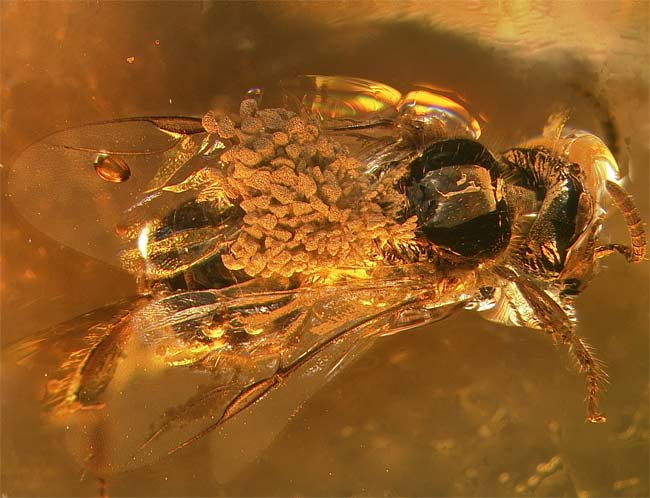Orchids Dated to Dinosaur Era

Dinosaurs might have gotten a whiff of orchids before the beasts' demise, newfound fossil remains suggest.
Encased in a block of amber, the remains of an extinct, stingless bee (Proplebeia dominicana) with a clump of orchid pollen stuck to its back indicate the flowering plants arose some 76 million to 84 million years ago, much sooner than many scientists had estimated.
"Our analysis places orchids far toward the older end of the range that had been postulated, suggesting the family was fairly young at the time of the extinction of the dinosaurs some 65 million years ago," said lead study author Santiago Ramirez of Harvard's Museum of Comparative Zoology and Department of Organismic and Evolutionary Biology.
The bee-with-pollen specimen, described in the Aug. 30 issue of the journal Nature, is one of very few fossils that illustrate directly the relationship between a plant and its pollinator, a phenomenon that has fascinated biologists since the time of Darwin.
Pollen packets
The specimen was recovered by a private collector in the Dominican Republic in 2000, but it wasn't until 2005 that the sample made its way to the lab of Ramirez and his colleagues.
By analyzing the position and shape of the pollen cargo, the scientists placed the orchid, dubbed Meliorchis caribea, within one of five living subfamilies of orchids.
Get the world’s most fascinating discoveries delivered straight to your inbox.
They conclude the bee acquired the grains through active pollination, as opposed to a random encounter. And in order to transfer the pollen packets to the bee's posterior, the orchid bloom must have been shaped in a particular way in which the anther (the pollen-containing flower part) was bent, the scientists say.
Orchid genesis
They estimated the specimen to be 15 million to 20 million years old, though its relatives could be placed further back in evolutionary time.
To estimate the ages of the major branches of the orchid family, they compared DNA from the pollen sample with DNA from other orchid species. The so-called molecular-clock method is based on an idea that differences between the DNA molecules of particular species is a measure of how long the two groups have been evolving independent of one another.
The results revealed certain groups of modern orchids evolved early during the rise of the plant family. For instance, they found present-day orchids in the genus Vanilla arose about 60 million to 70 million years ago.
The orchid species began to diversify and flourish, the scientists say, shortly after the dinosaurs went extinct.
- Backyard Bugs: The Best of Your Images
- Top 10 Poisonous Plants
- Do Plants Have Sex?
Jeanna Bryner is managing editor of Scientific American. Previously she was editor in chief of Live Science and, prior to that, an editor at Scholastic's Science World magazine. Bryner has an English degree from Salisbury University, a master's degree in biogeochemistry and environmental sciences from the University of Maryland and a graduate science journalism degree from New York University. She has worked as a biologist in Florida, where she monitored wetlands and did field surveys for endangered species, including the gorgeous Florida Scrub Jay. She also received an ocean sciences journalism fellowship from the Woods Hole Oceanographic Institution. She is a firm believer that science is for everyone and that just about everything can be viewed through the lens of science.


